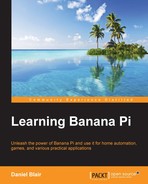This book is going to help you on your journey into single-board computing. We are going to cover a lot of topics that are popular in the community and build some skills that will help us when we are working on projects later on. The world of single-board computing is new and fast-paced but it opens up so many doors when it comes to education and technology. The Raspberry Pi (pictured here) is the inspiration for the Banana Pi.

Single-board computing is a relatively new technology that was popularized by the Raspberry Pi and really made it easy to prototype and learn. The Raspberry Pi brought cheap computing power to people around the world and empowered kids and hobbyists to learn about Linux and start to play with electronics. It brought out the maker in all of us and we started to build and see what we could do.
The Banana Pi allows you to take rapid prototyping to the next level. With an operating system directly on the board and access to the general purpose input output (GPIO) pins, you can not only set up a home theatre PC (HTPC), you can actually build the next great product using one.
Learning electronics is easier than ever when you attach the GPIO output to a breadboard and build directly from that. The Banana Pi, like the Raspberry Pi, is so small you can even incorporate it into a finished product and forego the need to implement another micro controller. The GPIO pins allow you to write code on the device that interacts with physical hardware such as LEDs, resistors, and switches. This means you can mock-up your idea, and get a working version of it before making a commitment to manufacturing something.

Coding is something that is becoming very important as a skill now, and with coding tutorials, and software that you can install directly on the Banana Pi, you can build skills that will be valuable to you for a long time. The Google Coder interface is pictured in the preceding screenshot.
The Banana Pi is usable as a web server, which means that you can learn languages such as Ruby, PHP, and Python directly on the board, or push code from your other computer to the Pi, which can act as your local development server. I have found projects such as Google Coder to be incredibly useful tools for learning these skills.
Popular development tools are available for the Banana Pi on Linux as long as there is an ARM-compatible build for it. This includes software such as gedit. You can also run web-based solutions (for instance, Adafruit's WebIDE, which runs as a web service directly on the Pi).

One of the most popular uses of the Raspberry Pi is as an HTPC or Media Centre PC. This means that the device is hooked up to a TV and used for the displaying of media. With tools such as XBMC (see the preceding screenshot) and Samba for file sharing, this is quite easy. The Banana Pi makes this even more accessible. What used to be a slower GUI is now sleek and fast and, with the built-in IR receiver, you can even use a remote to control the Pi from the sofa without the need for a keyboard and mouse. The SATA port on the M1 makes it faster than ever to get media to your TV due to the read/write speed of SATA being a lot faster than USB. The M2's built-in Wi-Fi is also very useful for this task.
Popular software such as Octoprint (used to control a 3D Printer—for example, the Printrbot) is also compatible with the Banana Pi. This allows you to directly connect your Banana Pi to your 3D printer and use that as a print server. You can send your 3D models to the Pi and have it slice up your model and start the print. This is one of my favorite uses for the Pi, something that also translates into rapid prototyping.
The Raspberry Pi took open source software and added a hardware aspect to it. Now for less than $100 you could have a cheap computer and that really got people excited. A huge community has grown from the Raspberry Pi, which has helped with the success of the board and has been the inspiration for newer boards with better specs such as the Banana Pi. The Banana Pi is a board that builds on the success of the Raspberry Pi. It is a single-board computer, which means that everything needed to operate on the system, is built-in, all you need to do is add your peripherals. The Banana Pi takes it a step further with increased stats and performance, which allow you to really take your projects to the next level.
The community for the Banana Pi is growing and you can already find projects and tutorials specific to it. The additional hardware such as the SATA port and Gigabit LAN has made it very popular for file servers or ownCloud. The nice thing is, you can still do everything you wanted to do with the Raspberry Pi, but with a little extra hardware. The following screenshot shows some hardware used to breadboard a Banana Pi.

